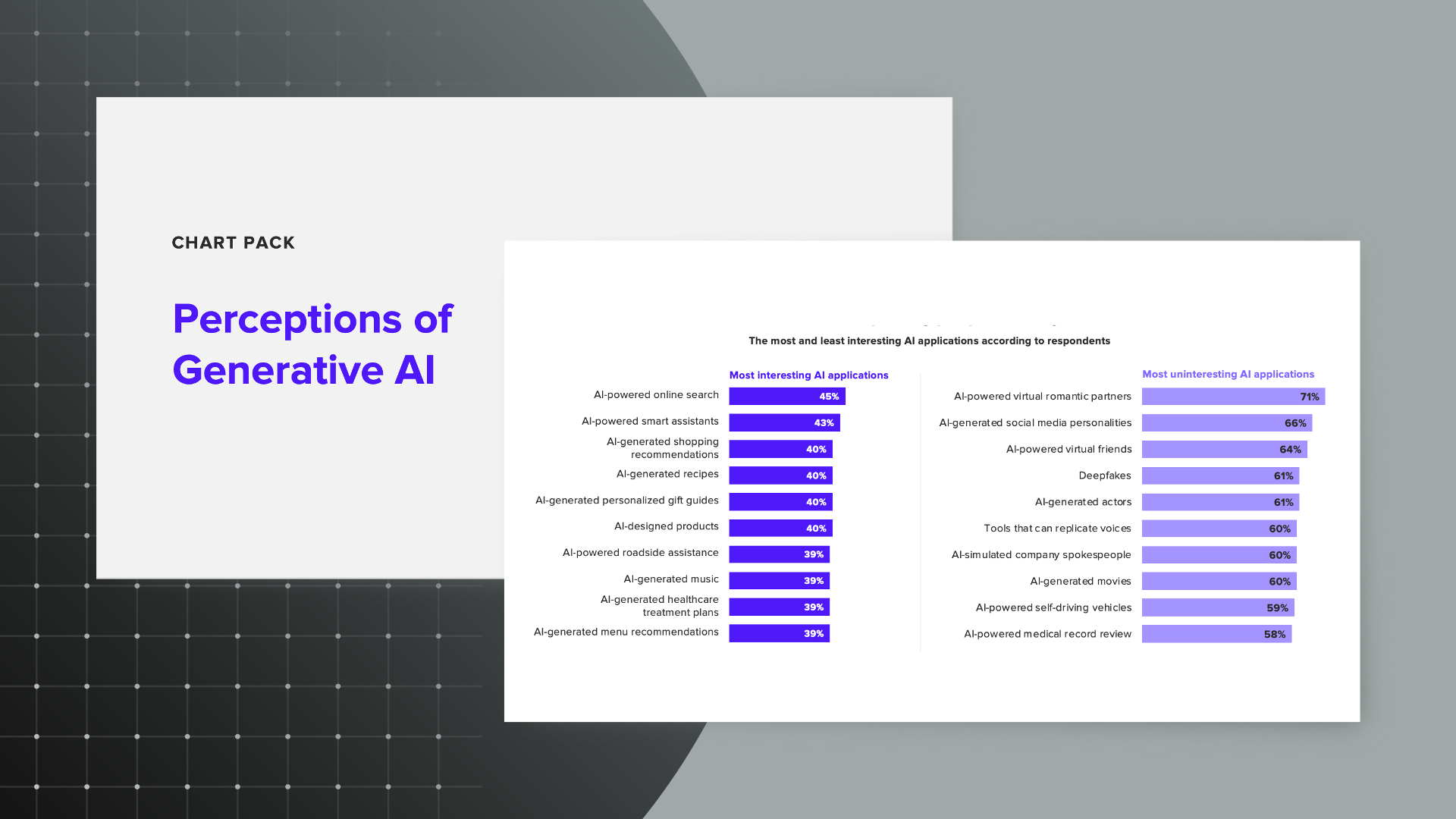How Financial Services Providers Can Win Over AI-Wary Consumers

Key Takeaways
Although financial services institutions have long been using AI, about half of U.S. adults are unaware of AI’s applications in the industry, and an even larger share feel put off by the idea.
Consumers trust banks and credit unions the most with AI, likely because they trust these institutions more overall. And across the industry, they’re more comfortable with use cases related to customer service and consumer protection than with those that could directly impact their finances.
The solution to these concerns could be as simple as education. Trust skyrockets across provider types and use cases among consumers who know their providers are using AI. The technology is also more popular among early adopters, giving providers a base to focus on as they ramp up their efforts and plan for 2024.
Data Downloads
For more on trends in the financial services industry, download our latest biannual report: The State of Consumer Banking & Payments.
Artificial intelligence has long been embedded in powering, shaping and informing financial services. But over the past year, the rise of generative AI and new services that integrate it, like ChatGPT and Bard, mean innovation is ramping up. As financial services players realize AI’s value-add potential, the rush to be the first to bring cutting-edge services to market, and beat both competitors and regulators to the table, has intensified.
AI’s raised profile is beginning to translate into consumer usage. New Morning Consult data finds that 2 in 5 U.S. adults report that they’ve used AI in some form in the past month. But many don’t know whether their financial institutions are doing the same. Just 1 in 10 consumers said they know for sure that their financial institutions use AI to serve them, whereas 18% think they do and nearly half don’t know. Meanwhile, most customers are not thrilled about the use of AI in the industry: Across financial services categories, around half of U.S. adults say they would prefer a provider that does not use AI.
Consumers Prefer Financial Services Providers That Don’t Use AI
These sentiments change the stakes for providers that are prepared to go big on AI in 2024. The technology is becoming more customizable, more accessible and more visible to consumers. But if providers don’t keep customer sentiment in mind as they shape their strategies for using and deploying the technology, they could see limited uptake of new tools — or worse, declining trust and user attrition — and lose any return on investment.
Financial services providers need to bolster trust to ease customer concerns about AI
Many consumers are put off by the big picture of AI in financial services for now, but providers could reel in more adopters by persuading customers that they can responsibly incorporate AI into their operations. Between 24% and 40% of respondents say they trust providers “a lot” or “some” to use AI. Trust is highest for banks and credit unions, life insurance providers, and credit card companies.
This is roughly in line with overall trust in the various types of financial institutions, which makes sense: Consumers are more likely to feel confident in how institutions they trust more overall will use a new technology, compared with those they trust less. But it also means that providers with less trust across the board, like fintechs, should tread more carefully with their plans to introduce AI — though this may not be an issue for their core users, who tend to be more tech savvy.
Specific demographics at scale: Surveying thousands of consumers around the world every day powers our ability to examine and analyze perceptions and habits of more specific demographics at scale, like those featured here.
Why it matters: Leaders need a better understanding of their audiences when making key decisions. Our comprehensive approach to understanding audience profiles complements the “who” of demographics and the “what” of behavioral data with critical insights and analysis on the “why.”
Moreover, the generational gaps in trust aren’t as wide as might be expected. Gen Z adults — who reported much more frequent usage of AI in the past month compared with adults overall — are slightly more inclined than the general public to trust financial institutions with AI, though differences are mostly within the margin of error. This suggests that consumers are simply nervous to let AI manage their financial assets and has less to do with their familiarity with the technology.
Consistent with the sizable group of consumers who don’t know if their providers are using AI, there are also many across all generations who don’t yet have an opinion on whether AI in financial services can be trusted. Providers should take this as a sign that consumers can be won over, rather than reversing course on their investments and go-to-market plans.
Trust in AI financial services is higher among consumers who are interested in new tech and aware that their providers already use AI
Early adopters of new technologies are much more inclined than the general public to trust financial services providers to use AI. For example, 55% of those who are among the first to try a new technology when it’s introduced said they trust credit card companies with AI a lot or some of the time, compared with 34% of adults overall. Targeting this demographic for pilots and rollouts, or leveraging them for word-of-mouth marketing, could help financial institutions refine their go-to-market strategies. Further, there’s only a single-digit gap between adults overall and late adopters of technology in general, which creates an opportunity to get the general public on board in the long term, when the technology is more established.
Consumers Are Most Likely to Trust Banks and Credit Unions to Use AI
A simple push to increase awareness could change public attitudes. When consumers know their provider is using AI, they’re considerably more likely to trust it to do so. Just 40% of adults overall trust banks and credit unions “a lot” or “some” with AI, but that figure rises to 75% among those who are aware that their providers are already using AI. Likewise, consumers who have used AI are more trusting of the technology compared with the general public, though the gap is smaller.
Educating users about the ways AI is and will be incorporated into various tools and services could go a long way toward building trust, given that around 7 in 10 consumers believe financial institutions should be transparent about their use of AI.
People are more comfortable relying on AI for fraud detection, customer service
AI also seems more palatable to consumers when they’re presented with specific use cases for the technology, indicating there’s enough appetite for AI applications to justify providers’ full-steam-ahead approaches.
Safety, Customer Service Are the Preferred Use Cases for AI in Financial Services
The most appealing AI use cases for consumers are related to customer experience and safety. Three in particular stand out:
- Fraud detection. Nearly half of U.S. adults (49%) said they would be comfortable with their providers using AI for fraud detection, something many financial services institutions have already been doing for years. Efforts to better inform digital safety-conscious customers — two-thirds of respondents said they are concerned about the privacy of their financial data — how AI can protect them might be an easy win in terms of building comfort.
- Customer service. More than 2 in 5 adults say they would be comfortable with AI being used for a customer service chatbot (46%) or digital assistant (41%). Many banks already have chatbots, like Capital One’s Eno, but generative AI is beefing up these services quickly. NatWest partnered with IBM to use generative AI to enhance its chatbot, Cora, to a new version, dubbed Cora+. And JPMorgan Chase is building a help desk that will offer personalized, step-by-step problem-solving. These tools are likely popular with consumers because they can simplify clunky processes and reduce pain points. Strong customer appetite is also a benefit to providers, which can use these tools to redirect human resources toward inquiries that are more complex or labor-intensive.
- Personalization. Nearly half of adults (46%) said they would be comfortable with AI-based personalized offers. This represents another easy win for providers, which can use the technology to build more compelling customer experiences that drive engagement (e.g., home screens that change based on customers’ usage patterns) or spending (e.g., personalized credit card rewards).
AI becomes dicier in consumers’ eyes when it is applied to financial decision-making rather than the customer experience. Consumers say they’re not yet ready for AI advisers, with large shares of adults feeling “very” or “somewhat” uncomfortable with financial institutions using AI for investment recommendations without human oversight (51%), digital financial advisers to help with transactions or advice (46%), or automatic or recommended loan approvals (44%). This could stem in part from concerns about bias related to race, gender and income.
Consumers are slightly more open to assisted decisioning and automated credit card approvals, which could offer financial services providers starting points as they explore the cost benefits of AI while accelerating their processes. Providers that introduce these features gradually — for example, with limited rollouts that target groups likely to be more receptive — could see the most success going forward.
Jaime Toplin previously worked at Morning Consult as a senior financial services analyst.


